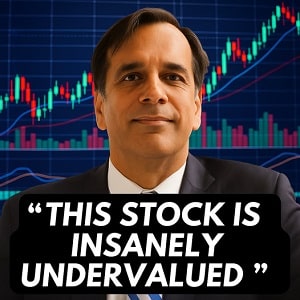In the dynamic world of financial markets, fluctuations are a constant reality that investors must navigate with astute awareness. Following a notable decline in the stock market on Thursday, stock futures have experienced a significant surge, signaling a potential rebound as traders recalibrate their strategies.
This shift comes in anticipation of an upcoming jobs report, which is poised to provide critical insights into the health of the economy and influence market momentum.
As we delve into the factors driving this volatility and the implications of the forthcoming data, it becomes increasingly essential for investors and market watchers alike to stay informed and prepared for the evolving economic landscape.
Recommended:
 The New Trump Era Is Here: Smart Investors Are Already Taking Profits — Are You?
The New Trump Era Is Here: Smart Investors Are Already Taking Profits — Are You?
Discover the surprising way you could make as much as $1,260 in as little as four days — starting this Monday (and that’s just the beginning)
The next batch Weekly Income Opportunities could hit your inbox this coming Monday.
Don’t let this opportunity slip away.
Stock Futures Surge as Markets Await Critical Jobs Report Data
Stock futures experienced a boost on Friday as traders attempted to navigate recent U.S. trade policy jitters that have unsettled the market this week. They were also gearing up for a crucial payroll report.
Futures linked to the Dow Jones Industrial Average climbed by 86 points or 0.2%. S&P 500 futures increased by 0.3%, while Nasdaq 100 futures rose by 0.4%.
Scheduled for release at 8:30 a.m. ET, the February jobs report is anticipated with bated breath. Economists surveyed by Dow Jones predict an increase of 170,000 jobs while estimating that the unemployment rate will remain steady at 4%.
This report follows a turbulent session on Thursday, which saw major averages slide back into sell-off territory as the latest concessions related to President Donald Trump’s tariff strategies failed to reassure investors. The Dow fell by over 400 points, and the Nasdaq Composite slipped into correction territory, finishing more than 10% below its recent peak.
The stock market has been on a tumultuous journey as Trump’s tariff policies raise concerns about future U.S. economic growth. Although Trump announced on Thursday that certain goods from Canada and Mexico, covered under the USMCA trade agreement, would be temporarily exempt from newly announced tariffs until April 2, this news failed to trigger a recovery akin to Wednesday’s rally.
“Markets are experiencing volatility as they try to assess the impacts of tariffs, which is a challenging task when circumstances shift rapidly,” explained Jamie Cox, managing partner at Harris Financial Group.
This latest market downturn seems to position the three major averages for their worst week since September 2024. The S&P 500 has fallen 3.6% week-to-date, while the Dow is down 2.9%. The Nasdaq has fared the worst, sliding 4.1% in the same timeframe.
Treasury Yields Fall as Investors Await Crucial Jobs Report
U.S. Treasury yields dipped slightly on Friday as investors weighed the implications of the latest tariff pause and braced themselves for the nonfarm payrolls report.
At 6:12 a.m. ET, the benchmark 10-year Treasury yield decreased by 1 basis point to 4.269%. Similarly, the 2-year Treasury yield also saw a decline of 1 basis point, landing at 3.95%.
One basis point equals 0.01%, and it’s important to note that yields and prices typically move in opposite directions.
Attention is fixed on the week’s key data release, the nonfarm payrolls report, which will be published by the Bureau of Labor Statistics at 8:30 a.m. ET.
This closely monitored report reveals changes in the number of employed individuals across the nation, providing insight into the robustness of the U.S. economy.
Economists anticipate that 170,000 jobs were added in February, an increase from January’s 143,000, while projecting that the unemployment rate remains stable at 4%, according to a Dow Jones survey.
Additionally, Federal Reserve Chair Jerome Powell is scheduled to speak later in the day, ensuring that investors will keep a close eye out for clues regarding future monetary policy.
Traders are also contemplating U.S. President Donald Trump’s recent tariff reprieve. According to a White House official, goods imported from Canada and Mexico into the U.S., in compliance with the North American trade agreement known as the USMCA, will enjoy a temporary exclusion from 25% tariffs, valid until April 2.
“Markets are volatile as they struggle to accommodate tariff implications, particularly when conditions shift so rapidly,” stated Jamie Cox, managing partner at Harris Financial Group.
Key Takeaways from the Upcoming February Jobs Report: What You Should Watch For
Recent contradictory signals from the labor market are increasing anxiety among investors already teetering on the edge concerning potential tariffs’ effects on inflation and economic expansion.
From various angles, employers appear either to be laying off workers at the fastest pace in years or maintaining current staffing levels with minimal changes.
What’s becoming increasingly evident is that employees are growing more uncertain about job security and less inclined to seek new positions, coinciding with reports from job seekers indicating difficulties in finding openings, as per several recent surveys.
These sentiment indicators contrast with generally solid figures reflected in traditional metrics like nonfarm payrolls growth and a jobless rate that still aligns with historical norms indicative of full employment and a bustling job market.
“Overall, conditions remain fairly stable in the U.S., but it’s important to acknowledge that there are signs of strain,” remarked Tom Porcelli, chief U.S. economist at PGIM Fixed Income. “One can choose to focus solely on the payrolls report, or recognize it as a lagging indicator, taking into account other metrics that reveal a softer underlying narrative.”
The Labor Department’s Bureau of Labor Statistics is poised to share its February nonfarm payrolls report on Friday at 8:30 ET. According to a Dow Jones poll, economists predict a job growth of 170,000, up from 143,000 in January, with the unemployment rate holding steady at 4%.
While this suggests a stable labor market, several caveats indicate that challenging times may lie ahead.
Outplacement firm Challenger, Gray & Christmas reported on Thursday that layoff announcements surged in February to their highest monthly level since July 2020, driven in part by Elon Musk’s Department of Government Efficiency, which aims to streamline the federal workforce. Challenger noted over 62,000 layoffs related to this initiative.
Current labor market surveys reflecting worker apprehension likely won’t influence Friday’s job figures due to the timing of these layoffs and the Bureau of Labor Statistics’ methods for tabulating household employment and jobs filled at companies.
Moreover, a recent Conference Board report pointed to an unexpected decline in consumer confidence, alongside a growing number of individuals anticipating fewer job openings available and finding it harder to secure employment. Additionally, a University of Michigan survey revealed a dip in sentiment as participants expressed concerns over rising inflation.
In economics, such fears can evolve into a self-fulfilling prophecy.
“When workers lack confidence in their ability to find new jobs, that hesitance manifests in the economy, similarly influencing employers’ hiring willingness,” cautioned Allison Shrivastava, economist with the Indeed Hiring Lab. “Sentiment should never be underestimated.”
Recently, economists have amplified their predictions concerning the impact of government job cuts, suggesting that multiplier effects linked to government contractors could lead to a labor force reduction of 500,000 or more.
“The reintegration of these workers into the economy will pose challenges,” Shrivastava added. “This also undermines confidence and sentiment, which can significantly affect the economy.”
Looking ahead, Goldman Sachs estimates the job cuts will only reduce the headline payrolls figure by approximately 10,000 and anticipates any weather-related effects to be minimal. The firm described the current employment landscape, as suggested by alternative metrics, as indicative of a “steady pace of job creation,” predicting continued but moderating contributions from catch-up hiring and recent immigration surges.
Alongside employment statistics, the BLS will unveil data on wage growth. Average hourly earnings are expected to reflect a 0.3% monthly increase, up 4.2% from a year earlier, slightly higher by 0.1 percentage point from January.
Recommended:

Luke Lango’s Great American Crypto Project is NOT just another newsletter… This is a quant-based algorithm Luke uses that is designed to identify a predictable pattern where cryptos could soar 10X, 50X even 100X in 90 days or less… We’re talking about the opportunity backtests show could turn a $1,000 investment into $21,330… $55,370… Even $116,140… In the matter of weeks!
Trump Establishes U.S. Bitcoin Reserve, Yet Bitcoin Remains Flat
Cryptocurrency prices remained relatively stable on Friday, despite President Donald Trump signing an executive order establishing a strategic bitcoin reserve for the United States, along with a “digital asset stockpile.”
Bitcoin’s value was holding steady at approximately $88,949.16, according to Coin Metrics. After the bitcoin reserve news broke Thursday evening, its price saw a dip of about 5%.
Earlier declines in other cryptocurrencies—particularly those that experienced a rally earlier in the week following Trump’s remarks on their inclusion in the strategy—eased, although Ether, XRP, and Solana’s SOL token all continued to trail in the red on Friday.
David Sacks, the White House czar for crypto and AI, elaborated on social media that the bitcoin reserve will comprise bitcoins already owned by the U.S. government, seized through past law enforcement actions—an initiative he emphasized will not burden taxpayers. Currently, the U.S. possesses over 198,000 bitcoins valued at roughly $17 billion, as reported by Arkham.
The stockpile of alternative cryptocurrencies will include “digital assets other than bitcoin seized in criminal or civil actions.” According to Sacks, the government won’t be procuring additional assets beyond those acquired through forfeiture proceedings. Arkham estimates the U.S. government holds about 56 ether tokens valued at nearly $119 million but does not account for XRP or Solana or Cardano tokens.
Initially, investors reacted negatively to the news suggesting that the U.S. wouldn’t make immediate bitcoin purchases as outlined in the order, particularly amid a broader equity market slump.
Sacks did clarify that the Secretaries of Treasury and Commerce have the authority to devise “budget-neutral strategies for acquiring further bitcoin,” as long as these strategies incur no additional costs for American taxpayers, and that there are no current plans beyond forfeitures to augment the crypto stockpile.
This announcement follows days after Trump hinted at further details surrounding the anticipated bitcoin reserve, a significant promise made during his campaign that has captured the attention of the crypto industry, coinciding with the first-ever White House Crypto Summit.
The cryptocurrency market has faced turbulence this week, influenced heavily by the ongoing tariff conflict and inflation fears, overshadowing the speculative enthusiasm surrounding the bitcoin reserve. JPMorgan indicated on Wednesday that it doesn’t foresee a significant uptick in cryptocurrency prices in the near future, due to overarching economic uncertainty and diminishing demand.
































